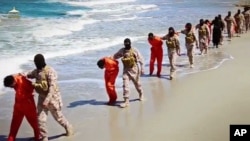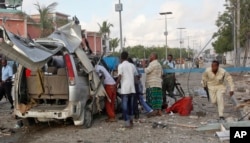The Syria-based Islamic State group has expanded its reach in Africa, courting Islamist extremists from Nigeria to Somalia while establishing a major nerve center close to Europe, a top leader of U.S. Africa Command told VOA.
The militant group has grown to about 2,000 strong in and around the city of Sirte, Libya, according to the U.S. Africa Command's Deputy for Military Operations, Vice Admiral Michael Franken. Back in February, there were a mere 200 Islamic State fighters in the city.
"If Raqqa [Syria] is the nucleus, the nearest thing to the divided nucleus is probably Sirte,“ said Franken, speaking in an interview at Africom headquarters in Stuttgart. “From there they look to export their terror into Europe and elsewhere.”
WATCH: Vice Admiral Michael Franken's interview with VOA News
It is beginning to appear that any counter-Islamic State strategy needs "serious elements" not only in regard to Syria and Iraq, but also Libya and Yemen, according to Brookings defense policy expert Michael O'Hanlon.
"Access from Libya to Europe is disturbingly easy," O'Hanlon told VOA. "Sirte looks like a real stronghold — and one with little prospect of being taken away from ISIL anytime soon."
Libya has become an importer of terrorists and the most important nexus for the Islamic State group in Africa, according to Franken. Libyan government officials have reported hundreds of foreign fighters in Libya, with many pouring in from neighboring Tunisia and Yemen.
Somalia shift
The terror group has now expanded its reach to war-torn Somalia, where about two dozen al-Shabab militants switched their allegiance from al-Qaida to Islamic State in late October.
Franken called the presence of 20-some Islamic State fighters in Somalia “insignificant.” The allegiance switch has proved “unhealthy,” he explained, as al-Shabab has managed to keep the shift “to a minimum” by attacking members who pledge loyalty to Islamic State.
VOA reported last week that al-Shabab fighters killed veteran group official Sheikh Hussein Abdi Gedi and four others after Gedi reportedly tried to convince members to make the switch to Islamic State.
Last month, nine al-Shabab members, including the allegedly pro-IS commander Sheikh Bashir Abu Numan, died in a factional clash near the town of Saakow.
Boko Haram
The latest developments in East Africa come months after West African terror group Boko Haram pledged allegiance to the Islamic State.
“We know there have been some Boko Haram fighters that went north and joined [Islamic State]. Fortunately, not many of them came back,” said Franken.
While the allegiance so far has failed to lead to “substantive cooperation,” Franken told VOA, the U.S. does expect that Islamic State has shared some tactics and techniques with the group. One example of this is the increased use of suicide bombers, which has raised Boko Haram’s lethality.
The tie between Boko Haram and other terror groups is why defense expert O'Hanlon also would like to see elements added in Mali and Nigeria to any counter-Islamic State or counter-al-Qaida plan.
The Islamic State group has thrived in volatile nations scarred by corruption, a problem that will take time to fix.
The U.S. has managed to create time and space for governments with its military operations across the continent, according to the admiral, but has “lagged” in making sure the tenets of good governance and society follow the operations.
Franken said more State Department workers and development officials are needed — more so than U.S. troops conducting counterterrorism and training operations — to right the African continent’s course.














